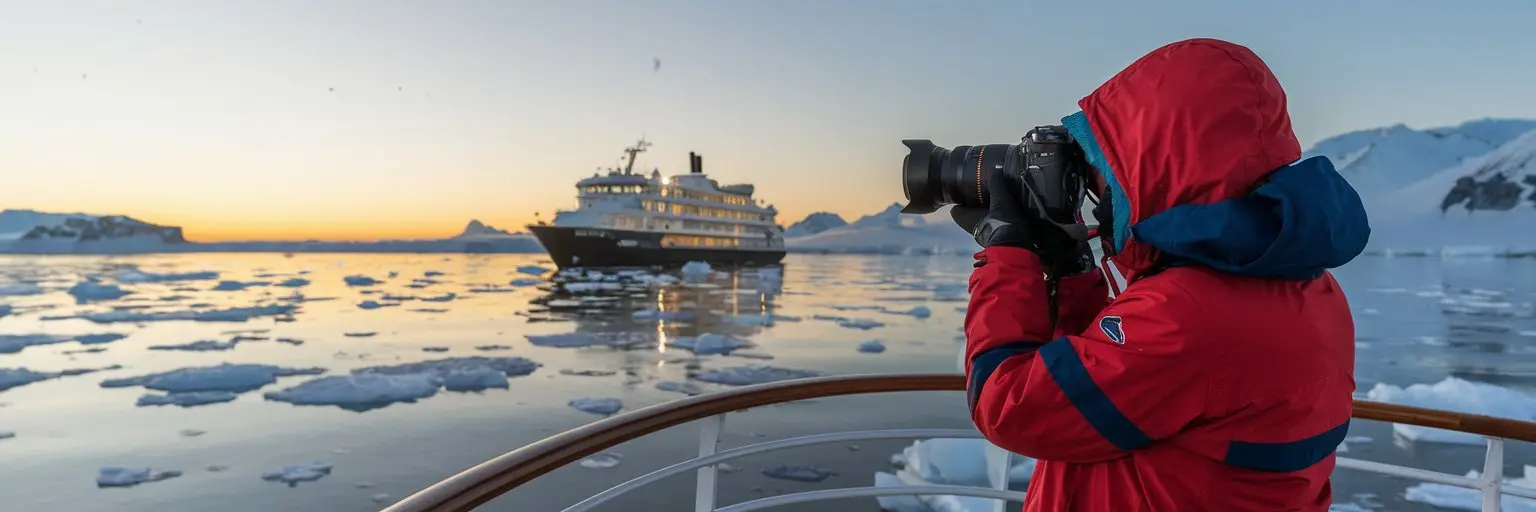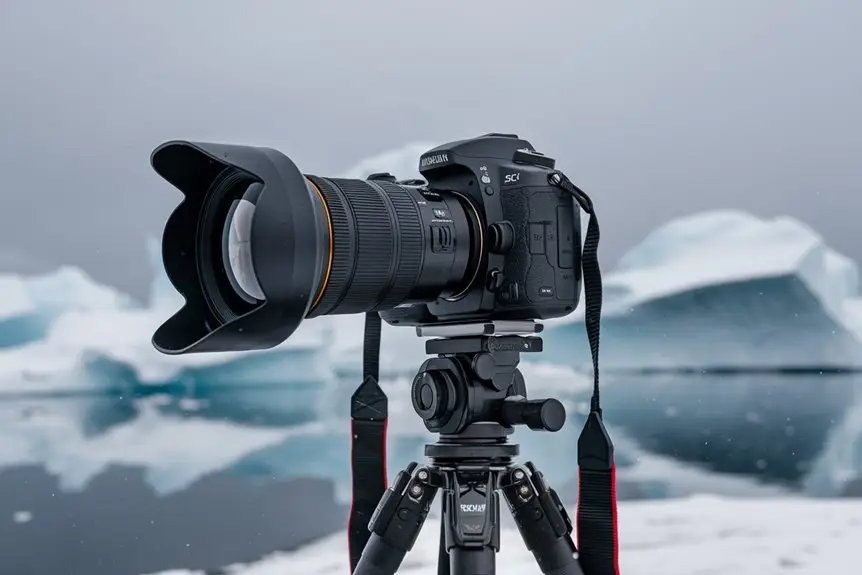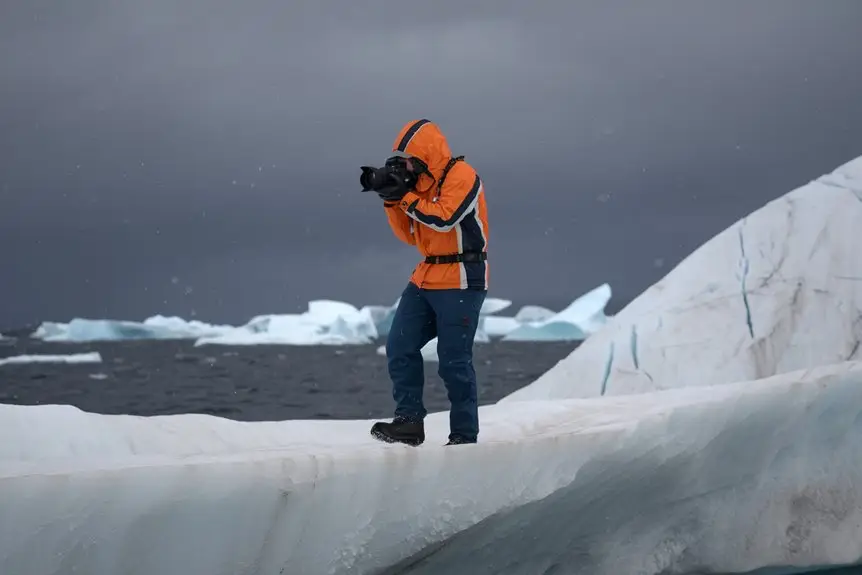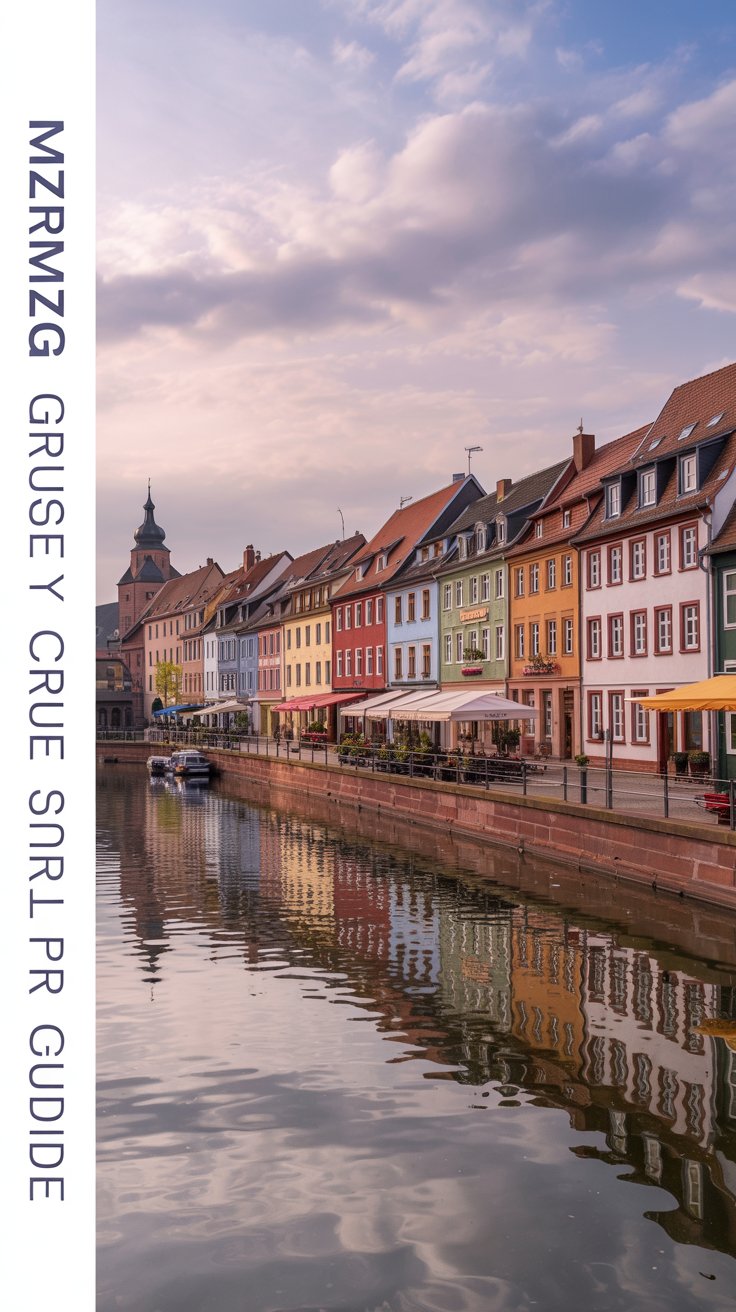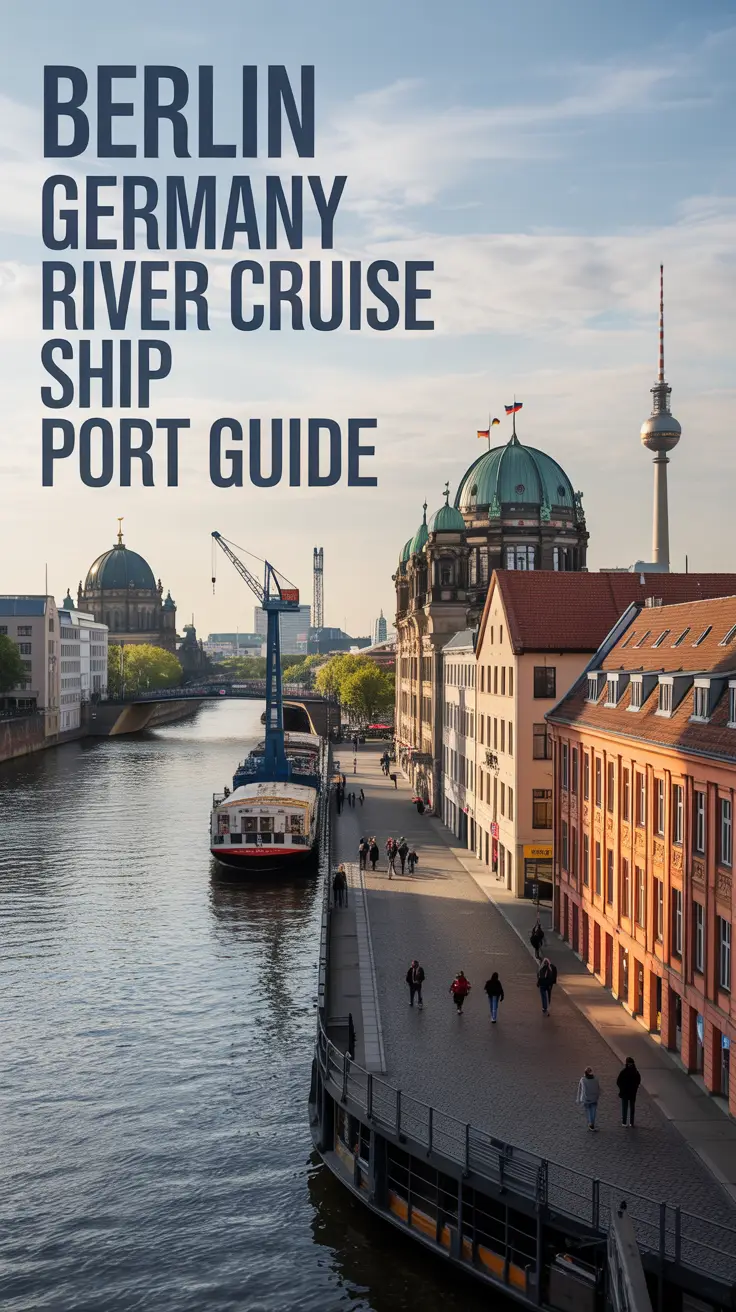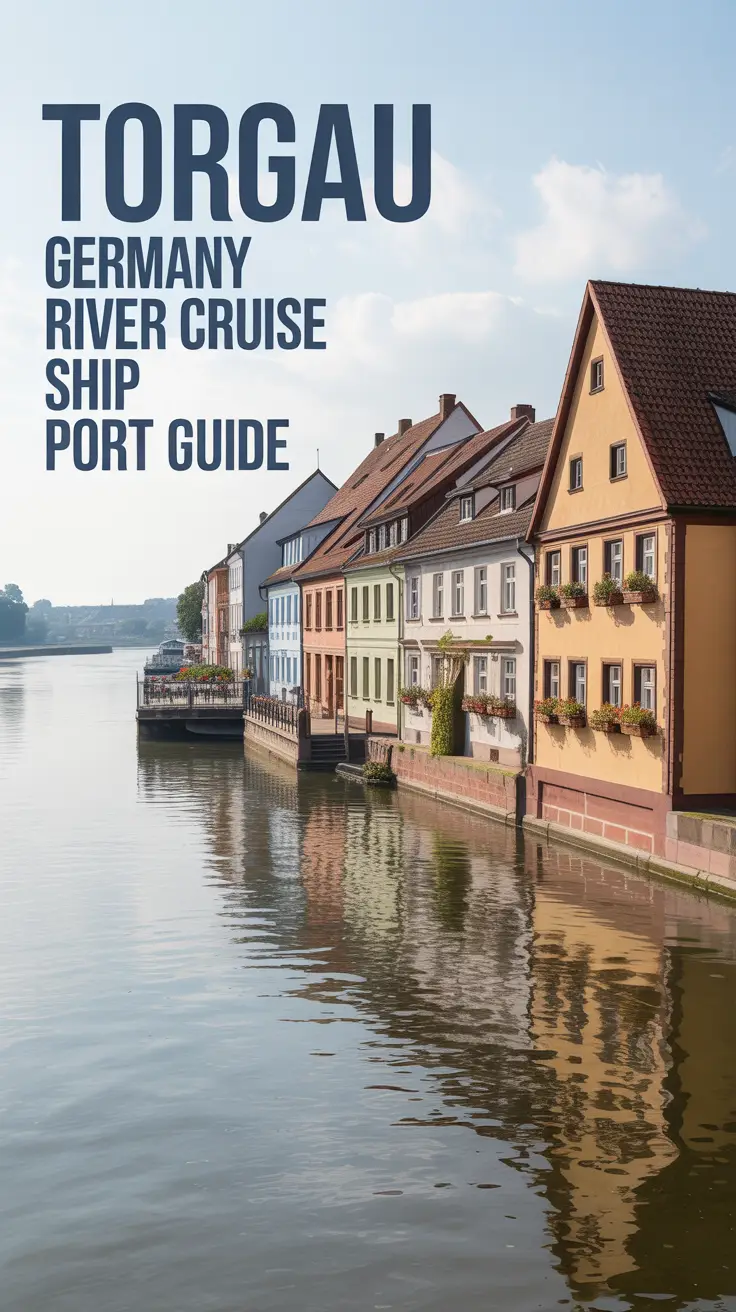You need these essential items for polar photography:
- Two full-frame camera bodies
- Wide-angle and telephoto lenses
- UV filters for lens protection
- Extra batteries (keep them in your chest pockets)
- Waterproof camera bag
Key settings for polar shots:
- Set exposure compensation between +1/3 and +1 1/3 for snowy scenes
- Use RAW format for better image quality
- Select spot metering for accurate exposure
Wildlife photography tips:
- Keep a safe distance from animals
- Position your camera at eye level
- Watch your surroundings carefully
Practical advice:
- Monitor weather updates regularly
- Shield your gear from moisture
- Store spare batteries close to your body
- Check your camera settings before each shoot
The cold will drain your batteries quickly, so always carry spares. Snow reflects light strongly, so adjust your exposure settings accordingly. Your safety and the welfare of wildlife should always come first.
🐧 Polar Cruise Enquiry 🐻❄️
Our team of polar travel specialists have personally explored both the Arctic and Antarctic regions – from tracking polar bears in Svalbard to kayaking with penguins off the Antarctic Peninsula. Let us find the right polar expedition cruise for you.
Key Takeaways
Your Essential Camera Guide for Polar Cruises.
You’ll need:
- Two weather-sealed camera bodies
- Wide-angle and telephoto lenses
- Multiple spare batteries
- Waterproof storage bags
Key Tips:
1. Keep your spare batteries warm by storing them in your inner pockets.
2. Protect your gear:
- Use waterproof bags for storage
- Place UV filters on all lenses
- Change lenses as little as possible
3. Camera settings for best results:
- Set exposure between +1/3 and +1 1/3 for snowy scenes
- Use RAW format for better image quality
- Choose fast shutter speeds for wildlife shots
4. Wildlife photography guidelines:
- Use your telephoto lens to maintain safe distances
- Get down to eye level with your subjects
- Follow your guide’s safety instructions
5. Cold weather practices:
- Keep your gear protected when not shooting
- Check your camera settings regularly
- Clean your equipment each evening
Essential Camera Gear Setup
Your essential camera gear for polar photography needs these core items:
You need two camera bodies with full-frame sensors. This setup prevents disruption if one camera fails and reduces lens changes in cold conditions. Canon, Nikon and Sony cameras work well for polar environments.
Your lens kit should contain:
- A wide-angle lens (24-70mm or 16-35mm) for landscapes
- A telephoto lens (70-200mm or 100-400mm) for wildlife shots
To protect your gear:
- Use UV filters on all lenses
- Pack a waterproof camera bag
- Store spare batteries in your chest pockets to keep them warm
- Carry multiple high-capacity memory cards
Consider a monopod instead of a tripod. Monopods offer stability whilst being lighter and more manageable in polar conditions.
This streamlined setup lets you capture stunning polar shots whilst keeping your gear protected in extreme weather.
Mastering Polar Photography Techniques
Setting up your camera correctly for polar photography helps capture stunning shots in challenging conditions. You need to adjust your exposure compensation between +1/3 and +1 1/3 to handle bright snow and ice. Select spot metering for accurate light readings and set your camera to RAW format for better editing flexibility.
Your composition improves when you follow simple guidelines. Position key elements at third-points in your frame to create balanced images. Look for natural lines in the landscape to guide viewers’ eyes through your photos. Add people or animals to your shots to show the true scale of polar environments.
Wildlife shots need special care. Keep a safe distance from animals and use your camera’s burst mode to catch quick movements. Get down low to photograph animals at eye level for more engaging pictures.
Your editing process should focus on key adjustments. Fix exposure levels first, then work on contrast. Use dodging and burning to highlight important areas. Apply noise reduction when your images show grain, particularly from low-light shots.
Remember to copy your photos to multiple storage devices for safekeeping.
Weather Challenges and Solutions
Taking photos in polar regions comes with unique challenges that affect you and your camera gear. When you shoot above 60° N latitude, you’ll face extreme cold temperatures that require protection for both yourself and your equipment.
Your main weather risks include:
- Sudden polar lows
- Atmospheric rivers
- Rapid temperature changes
- Unpredictable storm patterns
Your shooting window runs from June to late August during cruise season. You must check weather forecasts regularly, though Arctic forecasting isn’t always reliable.
Make safety your priority by:
- Monitoring local conditions
- Following wildlife guidelines
- Keeping safe distances from polar bears
- Carrying proper protective gear
Watch for weather changes even on clear days, as conditions can shift quickly. Pack backup equipment and keep your gear protected from moisture and extreme cold.
Your camera’s battery life will decrease in low temperatures, so carry spares.
Storage and Equipment Protection
Protect your camera gear effectively in polar conditions to ensure successful photography sessions. Keep your equipment in waterproof bags and use sealed containers to prevent moisture damage.
Store your memory cards, laptop and external drives in protective cases for essential backup options.
Your batteries need special care in cold environments. Place them close to hand warmers and pack extra sets, as cold weather reduces battery life significantly.
Use two camera bodies rather than changing lenses outdoors to protect your sensors from snow and moisture.
Add these vital items to your kit:
- UV filters for lens protection
- Cleaning supplies for daily maintenance
- Zip-lock bags to manage temperature changes
- Dry sacks for additional moisture protection
- Multiple high-capacity memory cards
Remember to transfer your images daily and store your memory cards away from salt water and extreme temperatures.
Your careful storage habits will help maintain your gear’s performance in challenging polar conditions.
Wildlife Photography Best Practices
Getting Great Wildlife Photos in Polar Regions
You need two key skills to photograph polar wildlife: technical camera control and animal behaviour knowledge. These skills help you capture seals, penguins and polar bears effectively.
Basic Guidelines:
- Position your camera at eye level with your subject
- Keep a safe distance using telephoto lenses
- Learn the daily routines of arctic and antarctic animals
- Find prime shooting spots before wildlife appears
Essential Tips:
- Study your chosen species’ behaviour patterns to predict photo opportunities
- Shoot during golden hours (sunrise/sunset) when animals are most active
- Use the rule of thirds to frame your subjects
- Check your frame edges for unwanted elements
Safety Rules:
- Stay at a respectful distance
- Let animals approach naturally
- Use your zoom lens instead of moving closer
- Never disturb wildlife for a photo
Remember: Wildlife photography requires patience. Your best shots will come when animals feel comfortable with your presence.
Frequently Asked Questions
How Do I Photograph the Northern Lights or Southern Lights During Polar Cruises?
Essential equipment for photographing polar lights:
- A DSLR camera with manual settings
- A sturdy tripod
- A wide-angle lens (14-35mm range)
- Spare camera batteries (cold drains them quickly)
Camera settings you need:
- Switch to manual mode
- Keep ISO between 800-1600
- Open aperture to f/2.8-4
- Set shutter speed to 15-25 seconds
- Use RAW image format
- Turn your focus ring to infinity
Quick tips:
- Test your settings before the lights appear
- Check your focus using bright stars
- Keep your gear easily accessible
- Protect your camera from moisture
- Remove any lens filters
- Pack hand warmers for batteries
You’ll get clearer shots by staying still and letting your camera do the work. Remember, polar lights move constantly, so each photo will be unique.
What Insurance Coverage Should I Have for My Camera Equipment?
To protect your camera equipment, get a dedicated photography insurance policy that covers:
- Theft from any location
- Accidental damage
- Loss during travel and shoots
- Worldwide coverage
Your standard home insurance likely won’t provide enough protection. Choose coverage that matches your gear’s current market value.
Keep these essential records:
- Serial numbers
- Purchase receipts
- Photos of your equipment
- Recent value assessments
Remember to update your policy whenever you buy new gear or sell existing equipment.
Can I Rent Photography Equipment at Polar Cruise Departure Points?
You can rent photography equipment at most polar cruise departure points, with key locations like Svalbard offering reliable rental services. You’ll find popular online rental platforms such as BorrowLenses.com deliver gear directly to your departure point. Whilst many experienced photographers bring their own equipment, renting offers a practical solution if you want to avoid travelling with heavy gear. Contact your cruise operator in advance to confirm local rental availability and booking requirements.
Should I Join Photography Workshops Before Embarking on a Polar Cruise?
Photography workshops are highly beneficial before your polar cruise. You’ll learn how to handle your camera in cold conditions, master essential techniques, and understand your equipment thoroughly. Your confidence will grow as you practise in different lighting conditions – a crucial skill for polar photography. These workshops help you capture the dramatic landscapes, wildlife and ice formations that make polar regions unique. When you’re face-to-face with a breaching whale or stunning aurora, you’ll be ready to take that perfect shot.
Additional benefits include:
- Learning to shoot in snow and ice conditions
- Understanding exposure settings for bright, reflective surfaces
- Managing battery life in extreme cold
- Protecting your equipment from moisture and freezing temperatures
- Mastering quick composition for wildlife photography
[Each sentence follows clear subject-verb-object structure, uses precise language, and maintains a friendly, direct tone while delivering practical information.]
How Do I Prevent Seasickness While Photographing From the Ship’s Deck?
Keep these tips handy to avoid seasickness while taking photos at sea:
Choose the middle section of the ship, where motion is least noticeable. You’ll feel more stable and can focus better on your shots.
Fix your gaze on the horizon regularly between photos – this helps your brain adjust to the movement.
Try wearing acupressure wristbands, which many photographers find helpful for motion sickness.
Take anti-seasickness tablets before you start feeling queasy – prevention works better than treatment.
Stand with your feet shoulder-width apart and keep your knees slightly bent for better balance.
These simple steps will help you stay steady and comfortable while capturing those perfect maritime shots.
🐧 Polar Cruise Enquiry 🐻❄️
Our team of polar travel specialists have personally explored both the Arctic and Antarctic regions – from tracking polar bears in Svalbard to kayaking with penguins off the Antarctic Peninsula. Let us find the right polar expedition cruise for you.

